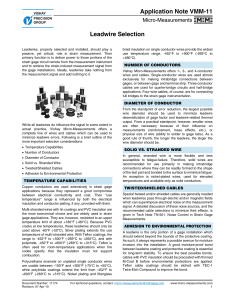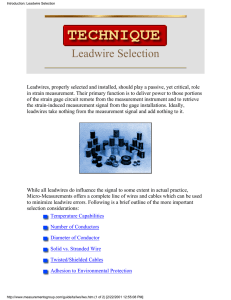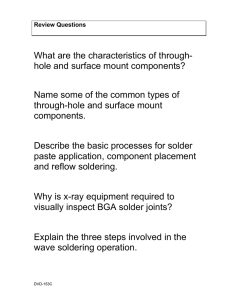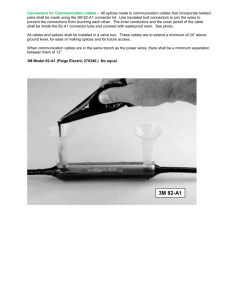VMM-11 Leadwire Selection
advertisement
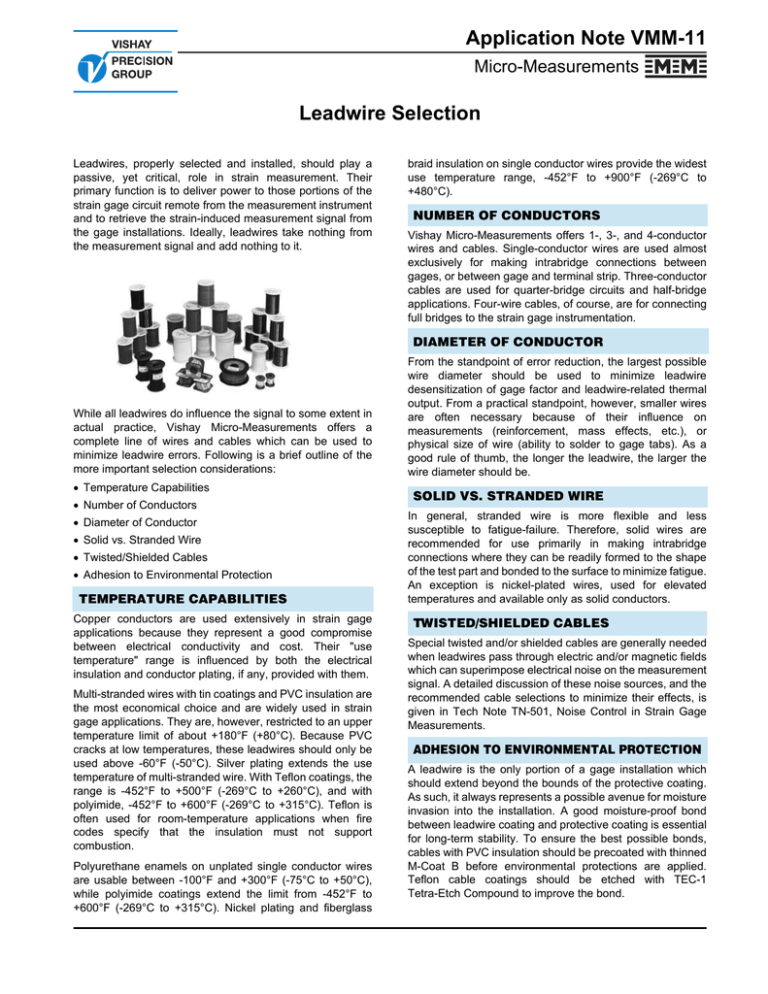
Application Note VMM-11 Micro-Measurements Leadwire Selection Leadwires, properly selected and installed, should play a passive, yet critical, role in strain measurement. Their primary function is to deliver power to those portions of the strain gage circuit remote from the measurement instrument and to retrieve the strain-induced measurement signal from the gage installations. Ideally, leadwires take nothing from the measurement signal and add nothing to it. braid insulation on single conductor wires provide the widest use temperature range, -452°F to +900°F (-269°C to +480°C). NUMBER OF CONDUCTORS Vishay Micro-Measurements offers 1-, 3-, and 4-conductor wires and cables. Single-conductor wires are used almost exclusively for making intrabridge connections between gages, or between gage and terminal strip. Three-conductor cables are used for quarter-bridge circuits and half-bridge applications. Four-wire cables, of course, are for connecting full bridges to the strain gage instrumentation. DIAMETER OF CONDUCTOR While all leadwires do influence the signal to some extent in actual practice, Vishay Micro-Measurements offers a complete line of wires and cables which can be used to minimize leadwire errors. Following is a brief outline of the more important selection considerations: • Temperature Capabilities • Number of Conductors • Diameter of Conductor • Solid vs. Stranded Wire • Twisted/Shielded Cables • Adhesion to Environmental Protection TEMPERATURE CAPABILITIES Copper conductors are used extensively in strain gage applications because they represent a good compromise between electrical conductivity and cost. Their "use temperature" range is influenced by both the electrical insulation and conductor plating, if any, provided with them. Multi-stranded wires with tin coatings and PVC insulation are the most economical choice and are widely used in strain gage applications. They are, however, restricted to an upper temperature limit of about +180°F (+80°C). Because PVC cracks at low temperatures, these leadwires should only be used above -60°F (-50°C). Silver plating extends the use temperature of multi-stranded wire. With Teflon coatings, the range is -452°F to +500°F (-269°C to +260°C), and with polyimide, -452°F to +600°F (-269°C to +315°C). Teflon is often used for room-temperature applications when fire codes specify that the insulation must not support combustion. Polyurethane enamels on unplated single conductor wires are usable between -100°F and +300°F (-75°C to +50°C), while polyimide coatings extend the limit from -452°F to +600°F (-269°C to +315°C). Nickel plating and fiberglass From the standpoint of error reduction, the largest possible wire diameter should be used to minimize leadwire desensitization of gage factor and leadwire-related thermal output. From a practical standpoint, however, smaller wires are often necessary because of their influence on measurements (reinforcement, mass effects, etc.), or physical size of wire (ability to solder to gage tabs). As a good rule of thumb, the longer the leadwire, the larger the wire diameter should be. SOLID VS. STRANDED WIRE In general, stranded wire is more flexible and less susceptible to fatigue-failure. Therefore, solid wires are recommended for use primarily in making intrabridge connections where they can be readily formed to the shape of the test part and bonded to the surface to minimize fatigue. An exception is nickel-plated wires, used for elevated temperatures and available only as solid conductors. TWISTED/SHIELDED CABLES Special twisted and/or shielded cables are generally needed when leadwires pass through electric and/or magnetic fields which can superimpose electrical noise on the measurement signal. A detailed discussion of these noise sources, and the recommended cable selections to minimize their effects, is given in Tech Note TN-501, Noise Control in Strain Gage Measurements. ADHESION TO ENVIRONMENTAL PROTECTION A leadwire is the only portion of a gage installation which should extend beyond the bounds of the protective coating. As such, it always represents a possible avenue for moisture invasion into the installation. A good moisture-proof bond between leadwire coating and protective coating is essential for long-term stability. To ensure the best possible bonds, cables with PVC insulation should be precoated with thinned M-Coat B before environmental protections are applied. Teflon cable coatings should be etched with TEC-1 Tetra-Etch Compound to improve the bond. Application Note VMM-11 Micro-Measurements Leadwire Selection The Vishay Micro-Measurements Strain Gage Accessories databook, presents an extensive selection of wires, cables, and accessories to handle a broad range of applications. Each has been thoroughly field tested and found to give excellent sensor performance when properly used in the specified environments. If you have any questions about the right leadwire for your specific application, our Applications Engineering Department will be pleased to make specific recommendations.
